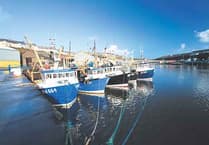RENOWNED South West jewellers, Michael Spiers, have expertly breathed new life into several prestigious ceremonial pieces belonging to Saltash Town Council, ensuring these treasured symbols of the town’s rich history continue to shine for generations to come.
Among the pieces meticulously restored were the Saltash Town Maces, the Mayoral Chain, the Saltash Oar Maces and the Saltash Wax Seal.
With precision, care and a deep appreciation for tradition, the skilled goldsmiths meticulously cleaned, polished and restored every intricate detail, reviving the splendour of these historic artefacts.
Their craftsmanship not only preserved these emblems of civic pride, but also reaffirmed their importance as lasting symbols of Saltash’s enduring heritage.

A spokesperson for Michael Spiers said: “The arrival of the Saltash Town Maces in our workshop was truly a breath-taking moment. These magnificent ceremonial pieces, each crafted from sterling silver showcases exquisite craftsmanship, with the stem adorned with symbolic motifs - the rose, shamrock, thistle and acorn - representing unity and heritage.”
“Atop each mace, three finely sculpted figures support the richly detailed head, which features:
- A three-masted ship, symbolising Saltash’s maritime legacy
- The Prince of Wales’ plumes, signifying royal association
- An anchor, representing the town’s strong naval connections
- The arms of the Buller family, honouring an influential local lineage
“The Mayoral Chain is a stunning piece crafted from 18ct gold, featuring 40 intricately designed links, each with its own unique story. Among these links, nineteen display the same shield, three are engraved with crests on the front and the names of mayors on the back, while the remaining links commemorate various past mayors.

“At the centre of the chain, a distinctively shaped shield records the historic Water Court of 1983. This shield depicts an ancient ship with a single mast and a furled sail. Attached to it is a remarkable medallion, inspired by the common seal used until 1886.
“Designed in the shape of St. John’s Cross, the seal features a lion-adorned shield, flanked by supporters, and crowned with a prince’s coronet resting above ostrich feathers - symbols closely tied to the Duke of Cornwall.”
The spokesperson continued: “We were also entrusted with two small silver oar maces. Dating back to 1760, these artefacts play a vital role in Saltash’s ceremonial traditions.
“Historically, the oar maces were carried by town sergeants as symbols of their authority when making arrests aboard vessels in the harbour. Their intricate design reflects their significance, with the Duke of Cornwall’s plumes adorning the top, while an anchor and ship are beautifully engraved on one side of each oar’s blade.

“Lastly, we were entrusted with the Saltash Wax Seal, a brass emblem beautifully marked with the Duke of Cornwall’s plumes. Accompanying the seal was a sterling silver inkstand.
“Inside the inkstand was a small note honouring Philip Syng, whose son, born in 1703, crafted the silver inkstand while in Philadelphia. While Philip Syng founded the business, his son continued his work and became a personal friend of Benjamin Franklin. Discovering this connection was truly thrilling, as it revealed Saltash’s ties to the broader world during this significant era.”
Restoring each of the pieces presented its own set of challenges, but none were too complex for the Goldsmiths, who employed a range of specialised techniques, ensuring Saltash’s rich history was not only preserved, but enhanced for future generations to appreciate.





Comments
This article has no comments yet. Be the first to leave a comment.